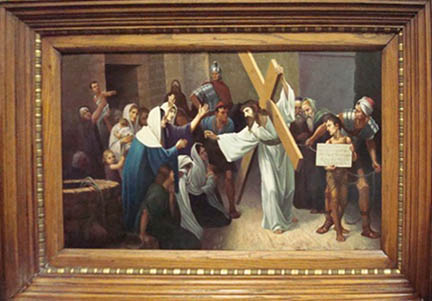Religious Art

Although the key imagery for each religion varies somewhat, the purpose of the artwork remains the same. Artists of the past and present strive to create beautiful works of art that honor their beliefs, tell the story of their faith, and attract others’ attention to the power of their chosen religion. Some of the most beautiful buildings, paintings, sculptures, and objects were created on behalf of religion. Representations of a religious nature have been found as far back as Neolithic sculptures and have developed through the ages into a rich and complex art form. The secular artworks of the last few centuries pale in numbers and depth to the numerous amount of priceless and breathtaking art that has been produced for the sake of religion.
Cairo, Athens and Rome
Ancient Egyptian craftsmen erected enormous temples to their gods, creating sculptures with a hybrid of human and animal characteristics. The Greeks and Romans, similarly, constructed large places of worship populated by countless statues adorned with precious stones and metals. Roman families had cabinets in their home decorated with terra cotta figures representing their ancestors and streets were adorned with religiously oriented talisman. This “pagan” religious art produced enormous buildings and delicate statues and reliefs that last to this day in cities such as Cairo, Athens and Rome.
Christianity & Judaica
The art of the Christian era is most strongly represented because it is an era that persists to this day. Beautiful churches of every style have been erected in the two millennia since its conception, a religion that has its spiritual and artistic roots in the Jewish faith. Christian paintings and sculptures of every style fill the world’s most prominent galleries. Christian art and themes were the key output of the vast majority of the western artists referred to as “Old Masters.” The Catholic Church of the Early Modern Era was the central employer of artists, and royal families also took advantage of artists not only to preserve their likeness but also to decorate their chapels and cathedrals.
Islam
Islamic art is unique for its general aversion to representing the human form. Islam places central importance on the message contained within the Quran, a message to be read and understood in its original Classical Arabic form. The centrality of the word means that Islamic artists took up the beautiful art of calligraphy, an art form that persists to this day. Mosques all over the world are adorned in unique and compelling Arabic calligraphy that conveys some of the most profound messages of the Islamic faith.
Religious Motifs
Religious art was the only option for many generations of artists up until the Renaissance, and in an effort to adapt to this they injected their own unique style and personality into representing the religious themes. Religious motifs persist in artwork today and will never disappear, but in the west religious artwork reached its peak during the age of “Old Masters.”
